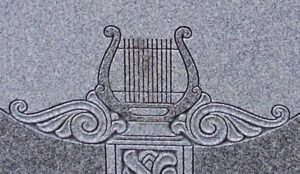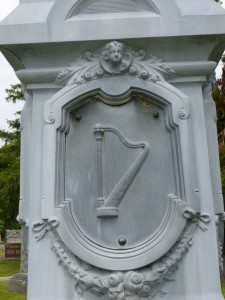A lyre or harp engraved on a tombstone is a symbol of heavenly music, praise to God, and the hope of heaven. Lyres and harps are often seen as the root of divine music.

Lyre Symbol, Greenlawn Cemetery, Wapakoneta, Ohio
The lyre is a stringed instrument with a U-shaped frame and is a member of the zither or harp family. A harp has an upright triangular frame with a curved neck. The strings on both are plucked with the fingers.

Harp, St. Joseph Cemetery, Auglaize County, Ohio
Lyres and harps are mentioned many times in the Bible but the first mention dates to before the flood, to a descendant of Cain. Genesis 4:21: His brother’s name was Jubal; he was the father of all who play stringed instruments and pipes.
Probably the most famous Biblical lyre player was young David, who was called in the night to play his lyre before the ailing King Saul. 1 Samuel 16:23: And whenever the evil spirit from God was upon Saul, David took the lyre and played it with his hand. So Saul was refreshed and was well, and the evil spirit departed from him.
The ancient Sumerians and Egyptians are the oldest civilizations that recorded the use of lyres and harps. The ancient Greeks used lyres and harps to accompany song and recitation and the lyre was the instrument of Apollo.
The lyre or harp symbol on a tombstone may indicate that someone of Irish heritage.



2 comments
Hello Karen, I am from north Columbus Ohio and went to school at Bowling Green. In looking up Chattanooga you are in Mercer County right on the Indiana line.
I moved to Colorado in 1981 and adopted a cemetery and pioneer church which was in great repair on Lookout Mountain. After research and restoration the cemetery and little church is a county landmark and listed on the Colorado State and National Register of Historic Places. It is called Historic Rockland Church & Cemetery (Historicrocklandchurch.org). The reason I found you is I was looking for the meaning of symbolism on many gravestones. The particular ones are a music lyre. I also have an interest in epitaphs. I am finding that that “laughter” is very popular word in epitaphs. Has that been your experience? I have many mountain landscape carvings on grave stones
I used this little cemetery, which is still active, for my thesis at the University of Colorado. (MA-History)
Author
What a great project and such a quaint church. I hope my tombstone inscription and symbolism information was helpful to you. I also enjoy finding and reading clever, humorous epitaphs. A sense of humor is a good thing. Thanks for writing and sharing the link. I enjoy hearing from a fellow cemetery enthusiast and former Buckeye.